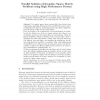Free Online Productivity Tools
i2Speak
i2Symbol
i2OCR
iTex2Img
iWeb2Print
iWeb2Shot
i2Type
iPdf2Split
iPdf2Merge
i2Bopomofo
i2Arabic
i2Style
i2Image
i2PDF
iLatex2Rtf
Sci2ools
HPCN
1997
Springer
1997
Springer
Parallel Solution of Irregular, Sparse Matrix Problems Using High Performance Fortran
For regular, sparse, linear systems, like those derived from regular grids, using High Performance Fortran (HPF) for iterative solvers is straightforward. However, for irregular matrices the e cient implementation of solvers in HPF becomes much harder. First, the locality in the computations (a good partitioning) is unclear. Second, for e ciency we often use storage schemes that obscure even the simplest structure in the matrix (like rows and columns). Third, the limited capabilities of HPF to distribute data structures make it hard to implement the desired distribution. Fourth, data structures often have very di erent sizes and shapes, and matching the distributions for e cient implementation (locality) is a problem. Fifth, after implementing the distributions, we still must write the program in such a way that the compiler recognizes the e cient implementation and leaves out unnecessary communication, synchronization, etc. We discuss techniques for handling these problems, and our re...
Cient Implementations | Data Structures | Distributed And Parallel Computing | HPCN 1997 | Irregular Matrices |
Related Content
| Added | 07 Aug 2010 |
| Updated | 07 Aug 2010 |
| Type | Conference |
| Year | 1997 |
| Where | HPCN |
| Authors | Eric de Sturler, Damian Loher |
Comments (0)

